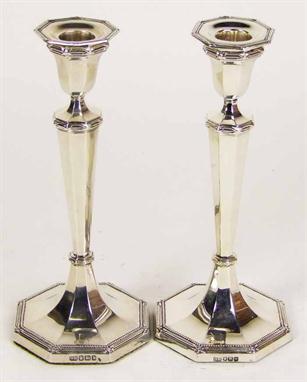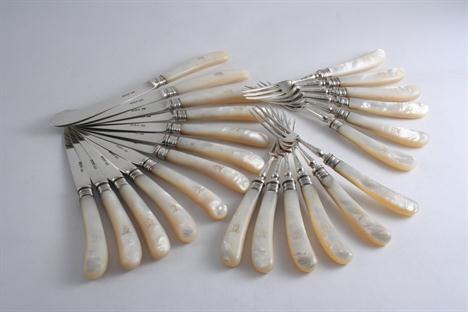6423 Preisdatenbank Los(e) gefunden, die Ihrer Suche entsprechen
6423 Lose gefunden, die zu Ihrer Suche passen. Abonnieren Sie die Preisdatenbank, um sofortigen Zugriff auf alle Dienstleistungen der Preisdatenbank zu haben.
Preisdatenbank abonnieren- Liste
- Galerie
-
6423 Los(e)/Seite
A FINE PAIR OF VICTORIAN SILVER SALMON SERVERS WITH CARVED MOTHER O`PEARL HANDLES, the blades pierced and engraved with foliate scrolls and engraved in a cartouche with a swan and bull rushes, embossed silver ferrules, the fish slice, 15" long, makers Harrison Brothers and Howson Sheffield 1854 EST 180-240
A Victorian silver six division toast rack, Harrison Brothers & Howson, Sheffield 1897, of rounded arched form with loop handle and wavy apron to base, 12cm high, weight 8ozWE DO NOT STATE CONDTION IN THE ABOVE DESCRIPTION – Before bidding please ensure you are satisfied with the condition of this lot – For details of condition please contact the auctioneer.
An Edwardian silver canted-rectangular bread basket by Harrison Brothers & Howson (George Howson), London 1907, with twin shaped scroll handles, egg-and-dart rim, bar pierced border, looped wirework sides with pierced and engraved foliate or covered urn reserves, on a canted-rectangular base, 32.5cm (12 3/4in) long, 638g (20.5 oz)
A circular waiter, with undulating moulded rim, raised on four pointed feet, with trophy inscription from Wrexham Golf Club, maker`s mark `P & S`, Sheffield 1923; and a plain waiter of similar design, maker`s mark of Harrison Bros & Howson, Sheffield 1925, total approx. weight 11 troy oz (2)
A canteen of Onslow pattern Georgian silver cutlery, various makers, London. comprising: 24 tablespoons, 24 dessert spoons, 35 teaspoons, 4 sauce ladles, 2 basting spoons and a soup ladle, with crests, 3357g in total; a set of Victorian silver Onslow pattern cutlery, Holland, Son & Slater, London, 1880, comprising: 24 table forks, 24 dessert forks, with crests, 2560g in total; a set of silver Old-English Thread pattern cutlery, Harrison Brothers & Howson, Sheffield, 1901 & 1928, comprising: 12 fruit forks and 12 fruit knives, one knife with later replaced blade; and a set of knives, comprising: 12 table knives and 12 dessert knives, composition handles and stainless steel blades, all contained in an oak canteen with brass carrying handles and a key (188)
A pair of late Victorian silver salt cellars, Charles Stuart Harris, London. each boat-shaped body with gadroon band, applied with two upswept scroll handles, on a spreading foot, with later blue glass liners, loaded; and two late Victorian silver salt spoons, Harrison Brothers & Howson, Sheffield, 1890, 10g in total (4)
Six pairs of Victorian engraved fruit knives & forks with silver handles embossed with roses, thistles, and shamrocks and engraved with crests Harrison Brothers & Howson, circa 1860 Together with eleven pairs of George III dessert knives & three pronged forks, sterling silver handles, circa 1780 Maker Thomas Farren, the handles engraved with initials Provenance Christie’s South Kensington 28.04.1986 Illustrated online at: www.mossgreen.com.au
Silver flatware comprising three George III silver Kings Pattern table forks, London 1815, makers mark WI over WI, a nother similar by William Chawner II, London 1825, five fiddle pattern silver dessert spoons, two serving spoons with thread pattern, possibly James Smith, Edinburgh 1837, a dessert spoon with bead pattern, G&S Co., London 1939 (24 ozs) and five ivory handled silver fish knives and forks, Harrison Brothers & Howson, Sheffield 1876 (two forks dating 1875)
A RUSKIN SANG DE BOEUF GLAZED VASE. Stamped "Ruskin England". 26cm high The English pottery studio Ruskin Pottery situated in the West Midlands was founded in 1898 by Edward R. Taylor, and was later run by his son, William Howson Taylor. The studio ware was named after the artist, writer and social thinker John Ruskin. The pottery was famed for the innovative glazes used on a range of brightly coloured pots, vases, buttons, bowls, tea services and jewellery. After receiving the award for the "grand prize" in 1904 at the St Louis International Exhibition this saw the beginning of their international recognition. The studio closed in 1935 and all the documents and formulae for the glazes were destroyed to prevent replication. A large collection of Ruskin Pottery is on public display at Wednesbury Museum and Art Gallery, England
-
6423 Los(e)/Seite



























































